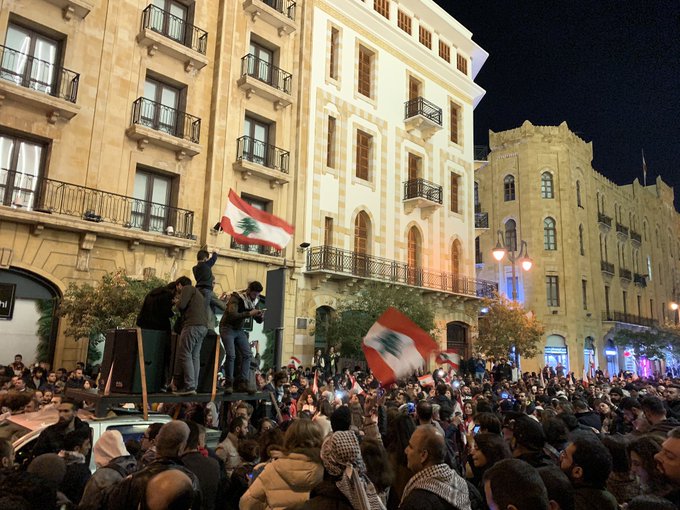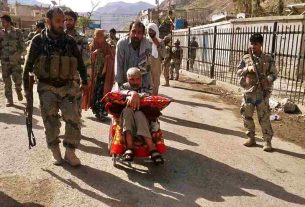Wed 29 January 2020:
When mass anti-government protests took over downtown Beirut on October 17, many participants felt that they were reclaiming a space that had long been sterile and off-limits. Now, new concrete blast walls have reemerged to keep protesters out of previously reoccupied space.
“At the start, the whole downtown area, was not for the people,” said Roula Abdo, one of a group of artists with the organization Art of Change who have been filling the walls of downtown with murals since the first weeks of the protests. “Now it looks a lot more like the people – it’s more popular, it’s closer to the people in the streets. The people gained the place back.”
In the post-war years, the downtown core was reconstructed by Solidere, a company connected to former Prime Minister Rafic Hariri, but the upscale shops that populated the city core were out of reach for most Beirutis, and many of the high-rise condominiums remained empty.
But in recent days – after weeks in which protests took a more confrontational turn, with hundreds injured in clashes between demonstrators and security forces, and ahead of Monday’s Parliament session to vote on the controversial 2020 budget – officials erected a new set of walls in the heart of downtown.
The new concrete blast walls blocked Nijmeh Square, where Parliament is located, and the Grand Serail, the seat of the Prime Minister. Protesters and supporters saw the move as an attempt to suppress dissent while also curtailing the public space they had been working to reclaim.
Immediately, Abdo set to work, using the newly erected walls as a canvas. In less than two hours on Sunday, she painted a piece depicting a pair of hands peeling open one of the new walls. Photographs of the mural quickly went viral on social media.
“Down with the wall of shame,” wrote activist Assaad Thebian above a picture of Abdo’s mural on Twitter, a turn of phrase that was echoed by many others.
Abdo said she meant the mural to be a sign of hope and defiance.
“Some people were starting to lose hope, with all the blockages and with all the people trying to stop us and get us out of the street,” she said. “So, my reaction was, no, we still have hope and we are going to go in, and we are going to break these walls and open these doors, because the Parliament is ours. We actually elected those people to represent us, so they cannot just keep us out and kick us out of our own place.”
On Monday, she followed up with another mural, on another section of wall, showing an eye peering through a keyhole. The new piece, she said, was meant to convey that authorities “are actually imprisoned behind the walls that they’re putting [up].”
The erection of the walls marked a reversal of a move by outgoing Interior Minister Raya al-Hassan, who had launched an initiative last February shortly after she was appointed minister to remove concrete security blocks around her ministry and elsewhere in Beirut. Hassan, who was greeted with high hopes by many as the first female interior minister in the region, had been criticized in recent weeks for allowing security forces to use excessive force on protesters and journalists.
Mona Fawaz, a professor of urban studies and planning at the American University of Beirut, noted that the struggle over public space in downtown Beirut is the continuation of a long history.
“Beirut’s historic core has been the site of contestation since the beginning of the civil war,” she said. “From the heart of Beirut, its most bustling space, downtown became a no man’s land where only militias’ strongmen could tread.”
Since 2005, Fawaz noted, downtown has been periodically occupied by protesters, “at times for a collective identity, often for specific groups who reclaimed it as ‘theirs.’”
At the beginning of the current uprising, she said, “We witnessed a somewhat spontaneous re-appropriation of space in which activists reclaimed through their use of various areas of downtown the city’s core as a space of collective discussion, celebration, and political voice.”
Coming after that reclaiming of space, Fawaz said, “The walls today are poignant testimony of the violence of the ruling elite and the lack of democracy in Lebanon. They delineate a territory for the so-called public representatives, the space where they can avoid hearing or seeing the people they claim to represent.”
Abdo said she is not discouraged.
“This is just a sign that they are actually afraid of the people now,” she said. “They are scared of what the people can do, because, for once, the people woke up and noticed that they really have a voice and they can change something.”
Think your friends would be interested? Share this story!





